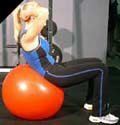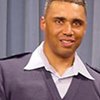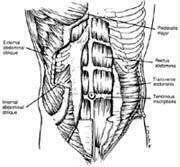How many infomercials have you seen where an "expert" says, "For the low-low price of $49.99 our product will help you get rid of your gut and develop the best set of abs on the planet!" In the ads, fitness models show the six pack attained by using Product X. Research shows "spot reduction" is impossible.
To have giant ravioli type abs, body fat levels must be reduced, so don't rely on the AB-roller, AB-maker, or AB-shaper to give you the chiseled look you desire. There are four primary ingredients for developing great-looking abs: cardiovascular exercise 3-4 times per week, effective ab exercises, eating foods low in fats, and the right set of genes.
The central function of the abdominal region is to provide a strong foundation on which both the upper and lower body moves. Let's briefly look at ab anatomy.
Ab Anatomy
There are four muscle groups that make up the abdominal area:
1. The Rectus Abdominis (RA) - The "RA" runs the length of the ab area from the pubic bone to the chest and pulls the torso toward the hips and the hips toward the torso. It's responsible for tilting the pelvis, which may affect the curvature of the lower back. Strengthening the "RA" will enhance performance in sports requiring jumping, running, and lifting objects. The "RA" when fully developed will provide you with the "six pack."
2. The External Oblique (EO) - The "EO" runs diagonally to the rectus abdominis and aids in the twisting of the trunk. The left external oblique is activated when twisting to the right, and the right "EO" is activated when twisting to the left. Strengthening this area will improve performance in sports where trunk rotation is important such as golf, tennis, and baseball.
3. The Internal Oblique (IO) - The "IO" lies underneath the external oblique and runs in a diagonally opposite direction. The "IO" muscle aids the trunk in twisting in the same direction as the side they are on. Strengthening this muscle will improve your performance in sports where you rotate the trunk, such as skiing, canoeing, soccer.
4. The Transverse Abdominis (TA) - The "TA" runs horizontally across the abdominal wall and along the midsection underneath the external and internal obliques. The "TA" pulls the abdominal wall inward, forcing expiration. Strengthening the "TA" will enhance performance in sports with short-term power activities such as karate, shot put, and football.
Effective Ab Exercises
The American Council on Exercise (ACE) recently sponsored a study (2) to find the most effective and least effective ab exercises. The study conducted by Dr. Peter Francis from the Biomechanics Lab at San Diego State University, compared 13 of the most common abdominal exercises and ranked them from most to least effective. The study consisted of 30 healthy women and men, ages 20-45, ranging from occasional to daily exercisers. They were put through a series of exercises, including the traditional crunch, modified crunches, partial body-weight exercises and exercises using both home and gym exercise equipment. Muscle activity was monitored during each exercise using electromyography equipment.
Each of the 13 exercises were ranked for muscle stimulation in the rectus abdominus (long, flat muscle extending the length of the front of the abdomen) and the obliques (long, flat muscles extending along the sides of the abdomen at an angle). Overall, the top three abdominal exercises were bicycle maneuver, captain's chair and crunch on exercise ball.
For best results, Dr. Francis recommends choosing several of the top-rated exercises and doing a five-minute exercise session daily. If one exercise is uncomfortable, try others until you come up with a variety that meet your needs. This will help train maintain muscle balance and prevent boredom (2).
According to the San Diego State University/ACE Abdominal Study (2) the following are some of the most effective ab exercises:
The Exercises
Bicycle maneuver- Lie flat on the floor with your lower back pressed to the ground. Put your hands beside your head. Bring knees up to about 45-degree angle and slowly go through a bicycle pedal motion. Touch your left elbow to your right knee, then your right elbow to your left knee. Keep even relaxed breathing throughout.
Captain's chair - Stabilize your upper body by gripping the handholds and lightly pressing your lower back against the back pad. The starting position begins with you holding your body up and legs dangling below. Now slowly lift your knees in toward your chest. The motion should be controlled and deliberate as you bring the knees up and return them back to the starting position.
 Crunches on exercise ball - Sit on the ball with your feet flat on the floor. Let the ball roll back slowly. Now lie back on the ball until your thighs and torso are parallel with the floor. Place hands behind your head (or cross your arms over your chest) and slightly tuck your chin in toward your chest. Contract your abdominals raising your torso to no more than 45 degrees. For better balance, spread your feet wider apart.
Crunches on exercise ball - Sit on the ball with your feet flat on the floor. Let the ball roll back slowly. Now lie back on the ball until your thighs and torso are parallel with the floor. Place hands behind your head (or cross your arms over your chest) and slightly tuck your chin in toward your chest. Contract your abdominals raising your torso to no more than 45 degrees. For better balance, spread your feet wider apart.
Vertical leg crunch - Lie flat on the floor with your lower back pressed to the ground. Put your hands behind your head for support. Extend your legs straight up in the air, crossed at the ankles with a slight bend in the knee. Contract your abdominal muscles by lifting your torso toward your knees. Make sure to keep your chin off your chest with each contraction. Exhale as you contract upward; inhale as you return to the starting position.
Reverse crunch - Lie flat on the floor with your lower back pressed to the ground. Put your hands beside your head or extend them out flat to your sides-whatever feels most comfortable. Crossing your feet at the ankles, lift your feet off the ground to the point where your knees create a 90-degree angle. Once in this position, press your lower back on the floor as you contract your abdominal muscles. Your hips will slightly rotate and your legs will reach towards the ceiling with each contraction. Exhale as you contract; inhale as you return to the starting position.
Traditional crunch - Lie on your back with knees bent and feet flat on the floor in front of you. Lie on an exercise mat rather than hard floor to prevent back strain. Position your feet hip distance apart. Place your hands behind your head so that your thumbs are tucked behind your ears. Hold elbows slightly out to the sides and keep chin pointing upward. Curl up and forward lifting your head neck and shoulder blades off the floor. Make sure you're not pulling your head forward with your hands.
Keep a fists distance between your chin and chest to be sure to target your abs and not strain your neck. Pause at the top of the movement and tighten your abs. Slowly lower your head, neck & shoulder blades as you inhale and return to starting position. Remember to keep knees bent and back straight throughout entire exercise.
In gyms all around the world, millions of people are spending hours upon hours working on their abs however, due to genetic characteristics, women may find it much more difficult to develop the sleek and shapely ab muscles they desire.
Ab Region: A Problem Area For Women?
A woman's pelvis consists of four bones (paired innominate bones, coccyx, and the sacrum) held together by ligaments. The size and shape of these bones have a tremendous impact on how a woman looks physically. The pelvic shape is classified by the "Caldwell-Moloy" system.
There are four "pure" pelvic shapes in this system:
- Android (A)
- Gynecoid (B)
- Anthropoid (C)
- Platypelloid (D) shaped pelvis.
The pelvis of any person may have some features of the opposite sex. A and C are most common in males, B and A in white females, B and C in black females, while D is uncommon in both sexes (3).
The android pelvis (sometimes called a "true male pelvis") is found in about 20% of American women. Women who happen to have such a pelvis tend to have "flat rear ends." Many of the "waif women" prominently seen in the industry modeling have this type of pelvis. Women with this shape of pelvis have virtually no real difficulty in achieving a flat stomach because their pelvises are similar to the average man.
 The gynecoid pelvis (sometimes called a "true female pelvis") is found in about 50% of the women in America. It is the "classic" form that we associate with women and has an anteroposterior diameter just slightly less than the transverse diameter. Lucy Lawless of Xena, Warrior Princess fame has a classic gynecoid pelvis. Women like this tend to be shapely and curvy and are able to have a flat stomach without really dropping body fat levels low enough to cause some female problems (i.e., irregular periods, fertility problems, and disrupt hormonal balance).
The gynecoid pelvis (sometimes called a "true female pelvis") is found in about 50% of the women in America. It is the "classic" form that we associate with women and has an anteroposterior diameter just slightly less than the transverse diameter. Lucy Lawless of Xena, Warrior Princess fame has a classic gynecoid pelvis. Women like this tend to be shapely and curvy and are able to have a flat stomach without really dropping body fat levels low enough to cause some female problems (i.e., irregular periods, fertility problems, and disrupt hormonal balance).
The anthropoid pelvis is very long and almost "ovoid" in shape. It is more common in nonwhite females (it makes up about 25% of pelvic type in white women and close to 50% in nonwhite women).
Women who have such a pelvis shape tend to have "larger rear ends" and may carry a lot of adipose tissue/weight in the buttocks as well as in the abdomen. These women can have a flat stomach with some real effort (they may have to drop body fat levels down a bit lower than women with the other two aforementioned pelvis types, but it's possible.
The platypelloid pelvis is very short (almost like a "flattened gynecoid shape"). Only about 5% of women have a true and pure pelvis of this type. Women having a platypelloid pelvis tend to carry a lot of weight in the lower abdomen. It's very difficult for these women to have really flat abdomens without getting body fat levels down into the single digits.
What does all this have to do with having a pouch? Since many women are a mixture of pelvic types no matter what they do, they are still going to end up with a little pouch in their abdomen region (1).
Another important factor in developing award winning abs is to carefully monitor your caloric intake. In order to bring out the ab muscles, plan on losing 1-2 pounds per week. Between 6-8 weeks from now, you should have an awesome set of abs on display
 "Never forget your abs!" says IFBB Fitness Pro and 1998 NPC Team Universe (Fitness) runner-up, Amy Yanagisawa. "They are your body's center of power and provide core strength. Strong abs aid balance, help prevent lower back injuries and promote good posture. Consistent abdominal workouts (10-15 min, 4-5x per week) performed correctly are not just for physical well being, but for aesthetics too. Another important tip is to be sure to keep track of your abs exercises in your workout journal so you know which exercises work best for you and produce the best results!"
"Never forget your abs!" says IFBB Fitness Pro and 1998 NPC Team Universe (Fitness) runner-up, Amy Yanagisawa. "They are your body's center of power and provide core strength. Strong abs aid balance, help prevent lower back injuries and promote good posture. Consistent abdominal workouts (10-15 min, 4-5x per week) performed correctly are not just for physical well being, but for aesthetics too. Another important tip is to be sure to keep track of your abs exercises in your workout journal so you know which exercises work best for you and produce the best results!"
There are dozens of ab exercises to help you maintain good posture, alleviate lower back pain, and improve your athletic performance. This article has provided you with the tools to develop an intelligent, varied routine that meets your specific training needs and goals. Finally, there is no magic formula that will make your abs appear. Nothing replaces the time and consistent effort you put into your quest for fantastic abdominals!
About The Author
Rob Wilkins is a Master Sergeant in the US Air Force stationed at The Pentagon, Washington, D.C. Wilkins is also a Special Assistant to the International Federation of Bodybuilders (IFBB) and a recipient of the IFBB Gold Medal. To contact Wilkins e-mail him at robifbb@yahoo.com.
Reference
1. www.testosterone.net, Oct 30, '98, No. 25
2. www.acefitness.com, American Council on Exercise (ACE), Study Reveals Best and Worst Abdominal Exercises, May 14, 2001
3 www.kumc.edu, Sexual Differences in the Pelvis (pg 337)
Thanks,

